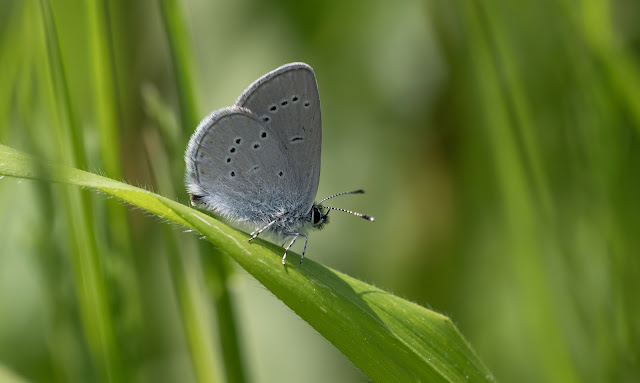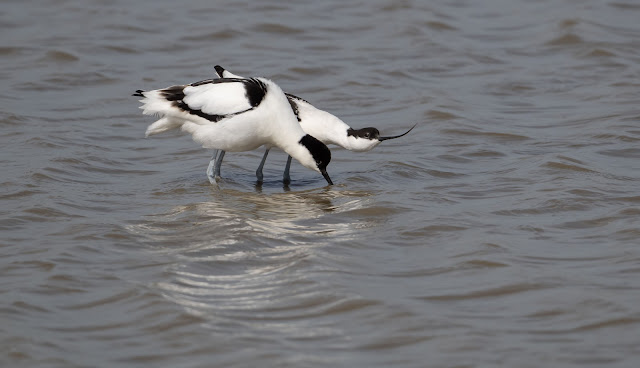As the continuing easterly winds remained, and my patch was getting later for butterflies compared to several other sites, I decided to head over to the downland around Lewes. It was an area I used to know well, as I was born and brought up in Lewes, not moving away until Pen and I married in 1981, when I was 22, so it was really nice re-discovering the area that I have rarely gone to, despite it only being around 15 miles away.
The day I went there was sunny on arrival, but after a while the clouds built up. I do actually quite enjoy days like that, as often the butterflies are active, and then go to roost, and are easier to find.
Before getting to the site, I looked through the binoculars down onto Lewes, and was pleased to see the house I was born in. It did take a few minutes searching to get the right area of Lewes, before I found it.
Once on the main site I walked slowly down the steep slope and it wasn't long before I found my first Green Hairstreak, and it was a lovely fresh individual.
Green Hairstreak.
As I ventured further across the slope I then found my first Dingy and Grizzled Skippers, as well as seeing the first reported Small Heath of the year in Sussex. This one was followed by a couple more of them.
Small Heath.
My real hope for the day was to see and photograph some Grizzled Skippers. After a while I stopped to eat a bit of lunch, and while I was doing this the clouds built up. After finishing lunch I had a quick look around and I noticed something on the top of a young bush. Looking through the binoculars I saw it was a Grizzled Skipper. I quickly took a few photos of the butterfly before the sun returned.
Male Grizzled Skipper at roost.
As the sun re-appeared, the butterfly flew a short distance to some fresh Bramble leaves. before opening its wings showing off what a lovely fresh individual it was.
Male Grizzled Skipper.
Soon the clouds built up again, and after finding a Dingy Skipper at roost, I decided to move around the hillside to a different area. I then spotted a mating pair of Grizzled Skipper. It looked as though the female had only just emerged when the male had found her, as she was extremely fresh. I was able to photograph them in 2 different positions as they moved from where I had originally found them.
Mating Grizzled Skippers. Female on left in both images.
The male did open his wings a couple of times, so I waited to see if the female would too. However, she stayed closed up. Whilst I was waiting I did have a look around the immediate area and found several Small Coppers. One I found roosting on a small Hawthorn sapling, and as the sun appeared very briefly it did open its wings.
Small Copper.
It was then back to the mating Grizzled Skippers. I had now been observing them for a couple of hours on and off, and I was still hoping that if the sun came out for any length of time, the female may open its wings. I could see that in the distance there was more blue sky getting nearer. Of course, as soon as the blue sky arrived, the butterflies split up and the male soon departed. However, the female only flew a very short distance and landed at the top of another Hawthorn sapling. I was able to get into position, so as the sun became stronger, I was able to photograph her as she opened her wings fully. It was fantastic seeing her gradually open.
Female Grizzled Skipper
Then, as the sun went behind yet another cloud, she closed up again.
Female Grizzled Skipper.
She then fluttered back down onto some Bramble leaves, and I was able to enjoy watching her as the late afternoon sun returned and she opened fully one more time.
Female Grizzled Skipper.
A few days later Lisa and I met up with our friends Graham and Joan, for a walk to see the Early Spider Orchids. We were also hoping to see some more butterflies, although, once again the sun was being a bit stubborn in coming out.
Eventually, I found a Dingy Skipper at roost on an old Knapweed seed-head. It then became a challenge for everyone to find other Dingy Skippers at roost. In the end, between us we found 4 of them.
Dingy Skipper roosting and hiding in plain sight.
We then headed on further to the main orchid site, seeing many of the lovely Early Spider Orchids. I have been going to this site for many years, and when I was a youngster, I did help the Nature Conservancy Council to count them sometimes. After the very dry spring this year, I was fearing that the orchids may have suffered, but there were plenty of them to see, even though the flowering season was a little shorter this year due to the dry conditions.
Early Spider Orchid.





















































